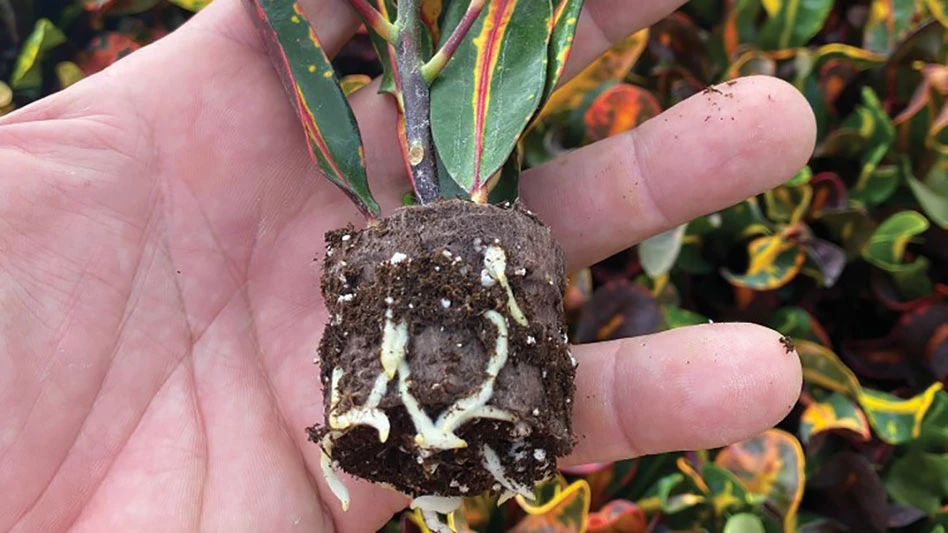
_fmt.png)

Nothing makes your heart sink like walking through propagation and seeing hot spots of brown. Questions arise; How many did we lose? Did they get treated? Is there resistance? Is there time to replant? Harmful pathogens do not clock out for the day while you’re sleeping, but fortunately, neither does Obtego!
Always active and never lazy, Obtego Fungicide & Plant Symbiont is an OMRI listed biofungicide with naturally occurring strains of fungi, Trichoderma asperellum strain ICC 012 and Trichoderma gamsii strain ICC 080. Each species possesses unique biological fitness that allows for a wider range of activity across greater environmental conditions (temperature, media, moisture, soil pH) and a broader spectrum of pathogens controlled. These antagonistic fungi work via multiple modes of action and are highly effective against soilborne pathogens that attack the root system and collar region of crops such as Fusarium spp., Phytophthora spp., Rhizoctonia spp., Rosellinia spp., Sclerotinia spp., Sclerotium rolfsii, Thielaviopsis basicola, and Verticillium spp.
The unique Trichoderma strains of Obtego are a preventative biocontrol acting by rhizosphere competence, colonizing the soil and roots, and creating a physical barrier at infection sites. This also keeps them unavailable to harmful pathogens, as well as competing with the damaging fungi for nutrients and water. The antagonistic properties of Obtego can directly parasitize the undesirable fungi by attaching to and penetrating them while producing enzymes that breakdown their cell walls. This process is known as mycoparasitism.
Obtego also establishes a beneficial mutualistic symbiotic relationship with the plant. This symbiotic relationship has shown increased lateral root development and root hairs, resulting in better nutrient uptake and quicker plant development. Studies show that Trichoderma spp. help boost the plant’s immune system in fighting off disease. Growers using Obtego report seeing rapid root development, faster and more complete seed germination, no disease and healthier looking crops.

Since Obtego requires colonization, it is essential that applications are made as early as possible to plugs, liners, or transplants, and at least one follow-up application. If disease is already suspected, Obtego is a compatible tank-mix with most synthetic drench fungicides. Trials show Obtego performs as well as synthetics as a preventative and yields more live plants when combined with Mefenoxam in inoculated trials.
Several physical benefits of Obtego include storage at room temperature and no refrigeration requirements and the ability to ship directly to the grower. Obtego readily goes into a fine suspension that will not clog injectors, screens or emitters, and it won’t leave a sticky residue behind after application.
Growers have several options when applying Obtego. It may be used as a pre/post-plant drench using as little as 2.5 ounces per 100 gallons of water. Most growers have observed best results at 3.0 ounces to 5.0 ounces per 100 gallons. Obtego has proven to be very economical; 100 gallons of Obtego solution will cover 800 to 1,000 propagation trays and about 6,400 four-inch planted containers.


Obtego may be used as a direct-stick or dip for cuttings in lieu of IBA (indole-butyric acid). Simply stick cutting into Obtego powder or a solution of 0.25lb to 2lbs of Obtego per gallon as a dip for cuttings, bulbs, and bare-root. After a direct-stick trial, one grower says Obtego produced a volume of roots that usually takes more than thirty days to achieve with IBA. Extensive 14-day root development was also observed by the grower in many other echeveria species.
Obtego may also be used as a substrate mix at 0.5lb to 1.5lbs per cubic yard, chemigation at 2.5lbs to 5 lbs per acre, pre-plant dust, and banded or broadcast ground applications.
Obtego has an extensive list of crops that it may be used on including bushberries, caneberries, cucurbits, fruiting and leafy vegetables, herbs, citrus, ornamental bulbs, annuals, perennials, trees, tropical foliage, woody ornamentals, turfgrasses and even organically grown crops.Disease management can be quite simple with a sound approach and knowing the crop you are dealing with.
- What are its known nutrient requirements, pests and diseases, and environmental stresses?
- Keeping propagation processes, equipment, benches, greenhouses, and water sources clean is critical and sanitation is key.
- Inspect incoming cuttings, plugs/liners, and plant material for preexisting issues.
- Schedule scouting based on need, not the calendar.
- Integrate biological controls, along with synthetics to aid with resistance management.
Fungicide resistance is one of the many challenges our industry faces. Growers have relied on the same chemistries to control pathogens in their crops for years. Some of these have become less effective with significant use over time. Utilizing multiple modes of action can help combat resistance. As a FRAC BM02, Obtego naturally fits into almost any IPM program.

Explore the March 2023 Issue
Check out more from this issue and find your next story to read.
Latest from Greenhouse Management
- Anthura acquires Bromelia assets from Corn. Bak in Netherlands
- Top 10 stories for National Poinsettia Day
- Langendoen Mechanical hosts open house to showcase new greenhouse build
- Conor Foy joins EHR's national sales team
- Pantone announces its 2026 Color of the Year
- Syngenta granted federal registration for Trefinti nematicide/fungicide in ornamental market
- A legacy of influence
- HILA 2025 video highlights: John Gaydos of Proven Winners





